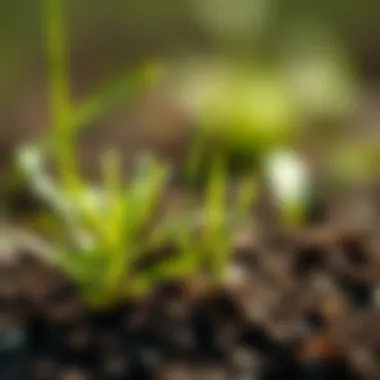Understanding Grass Seed Germination: Key Factors and Insights


Intro
Successful grass seed germination is the backbone of lush lawns and thriving landscapes. Without an in-depth understanding of the nuances involved in this process, it’s easy for even seasoned gardeners to face challenges. Factors including environmental parameters, soil conditions, and even the time of year all play significant roles in how well grass seed takes root.
The journey of a seed from dormancy to full growth isn’t merely a matter of waiting for rain and sunshine. Each stage, from seed selection to the care given post-germination, is a critical puzzle piece in achieving a flourishing green space. Let’s dive deeper into the factors affecting grass seed germination and uncover effective techniques to maximize success in your gardening or agricultural pursuits.
Latest Trends in Agriculture
Understanding the latest trends in agriculture offers insights into effective, modern practices that promote healthy growth and sustainability.
Overview of Current Trends
Today, more farmers and gardeners are showing interest in innovative techniques that improve seed germination rates. This includes the use of biostimulants, which are substances that enhance the natural growth process of plants. Additionally, the focus on drought-resistant grass species has gained traction, helping growers adapt to changing climate patterns. These seeds often require less water while still providing robust growth.
Impact of Technology on Farming Practices
Technology is shaping the agricultural landscape significantly. Drones, for instance, enable farmers to monitor crop health and conditions remotely, streamlining the management of large fields.
Information technology has also paved the way for precision agriculture, where data is analyzed to inform decisions about soil and seed conditions. Using sensors to measure soil moisture levels ensures that water isn’t wasted and allows for improved grass seed germination results.
Sustainable Practices: Towards a Greener Future
As the pressures of climate change mount, sustainable practices are becoming central to farming and gardening methods.
Importance of Sustainability in Agriculture
Sustainability is not just a concept; it’s a necessity in modern agriculture. Healthy soils contribute to vigorous plant growth and can improve the overall ecosystem. The emphasis on organic fertilizers and the reduction of chemical pesticide usage is essential for maintaining soil health and biodiversity, thus promoting better germination periods for grass seeds in the long run.
Methods for Sustainable Farming
Implementing sustainable practices can take many forms, including:
- Crop rotation: Prevents soil depletion by alternating types of crops, fostering richer soil for subsequent plantings.
- Cover cropping: Use plants that protect and enrich the soil during off-seasons, enhancing soil structure and nutrient content.
Such practices create a fertile environment, ensuring the seeds have the best chances of successful germination.
Gardening Techniques and Tips
A good gardener knows that even the smallest technique can lead to significant results.
Essential Gardening Tools and Equipment
A set of reliable tools can make or break your experience in seed germination. A quality seed spreader, for instance, allows for even seed distribution, while a soil thermometer can help ensure optimal planting temperatures, a key factor in germination. Don’t forget essential kits including trowels, rakes, and pruning shears.
Seasonal Gardening Practices
Understanding the seasons and their impacts on grass seed germination can help you time your planting effectively. Early spring is generally ideal for most grass types, as the soil begins to warm, promoting strong growth. On the flip side, avoid late summer planting, which can lead to premature seed dormancy when temperatures soar.
When all factors come together — the right seed, appropriate techniques, and attentiveness to environmental variables — you pave the way for a successful lawn establishment. Armed with this knowledge, you’re well on your way to becoming not just a gardener, but a steward of green spaces that thrive.
Prelims to Grass Seed Germination
Understanding how grass seed germinates is more than just an academic exercise; it's a keystone in cultivating lush landscapes and thriving lawns. This intricate process reflects a symbiotic relationship between various environmental factors and the inherent characteristics of the seeds themselves. When one dives into the nuances of seed germination, myriad elements come into play, each critical in determining how well grass establishes and flourishes.
The Importance of Grass Seed Growth
The growth of grass seed holds significance not only for aesthetic appeal but also for environmental benefits. Healthy grass plays a vital role in soil stabilization, preventing erosion and supporting biodiversity. Moreover, grass sequesters carbon dioxide, contributes to the oxygen supply, and can improve soil health through the addition of organic matter.
In practical terms, understanding how grass seed grows means better lawns that withstand the tests of weather and wear. Factors like proper watering, the right soil conditions, and effective seed choices can influence outcomes dramatically. For anyone invested in landscaping or agriculture, the knowledge of seed germination can lead to not just better grass, but healthier ecosystems.
Overview of the Germination Process
The germination process itself is deeply fascinating yet precise. It all begins when a seed absorbs water, triggering metabolic processes within. This phase marks the start of a robust transformation from dormancy to active growth. Generally, the process unfolds through these stages:
- Seed Absorption: The seed takes up moisture, causing it to swell.
- Radicle Emergence: The first root, or radicle, starts pushing down into the soil, seeking nourishment and anchorage.
- Shoot Development: Following the root, the shoot emerges, guided toward the light, ultimately developing into the blades of grass.
"The dance of growth happens not in isolation but in response to the surroundings, reflecting the delicate balance of moisture, temperature, and light."
Understanding these steps helps gardeners and farmers anticipate the needs of grass, ensuring timely interventions that support germination. Problems that arise during this crucial phase, such as insufficient light or excessive moisture, can be detrimental.


Evidently, grappling with the germination of grass seed empowers individuals to make informed decisions, fostering not just growth but a thriving environment.
Key Factors Influencing Germination
When it comes to the successful germination of grass seed, there are several pivotal elements that play a role. Understanding these factors can mean the difference between a lush, green lawn and a patchy, struggling one. It’s not just about throwing some seeds onto the bare soil and waiting; there’s a bit more fine-tuning involved. Each component, from the very environmental conditions to the type of grass seed you select, holds influence over how effectively those seeds will sprout and grow.
Environmental Conditions
Temperature
Temperature is perhaps one of the most significant factors in the germination of grass seed. Each type of grass has its preferred range that unlocks its growth potential. Cool-season grasses, for example, thrive between 60°F to 75°F, while warm-season grasses do best in temps ranging from 80°F to 95°F. It's all about creating that right atmosphere for them.
One notable aspect is that temperature impacts enzyme activity inside the seed. When it’s within that sweet spot, enzymes kick into gear, initiating the process of germination, breaking down stored nutrients to fuel growth. However, if the temperature dips too low or spikes too high, germination can slow down or even halt entirely. Extreme heats or frosts can be detrimental, making navigating local climate conditions essential for optimizing seed germination.
Moisture Level
Moisture builds the foundation of life—quite literally when it comes to grass seed germination. Most seeds need a consistent moisture level to sprout. If the soil dries out, seeds may fail to germinate, and if it’s overly wet, the seeds might rot. This balance is all about creating a Goldilocks zone; just enough moisture without drowning the seeds.
Throughout the germination process, the seed absorbs water, activating metabolic pathways and prompting it to break dormancy. Typically, seeds like to have a good soak before popping out of the soil, hence the importance of initial watering right after seeding. One unique feature of good moisture management is applying a light mulch layer to retain soil moisture while also reducing evaporation. The downside lies in the challenge; managing soil moisture often requires attention, especially in fluctuating weather conditions.
Light Exposure
Light is another key factor affecting how grass seeds germinate. While some seeds can germinate in low light, others require sunshine to sprout. For instance, sensitive seeds like certain fescue types thrive when exposed to direct sunlight, while shade-tolerant varieties may struggle in overly bright spots.
The characteristic of light exposure relates to photosynthesis, a vital process grass relies on once it grows. However, not all seeds react the same; too much light intensity can lead to excessive heat, stressing the seedlings out. In contrast, too little light can lead to weak, leggy growth. Understanding the light requirements of particular grass types prepares one for better placement in gardens or yards, ensuring seeds get just the right dose of sunlight.
Seed Type and Selection
Cool-Season Grasses
Cool-season grasses are ideal for areas that experience cold winters. Varieties like Kentucky bluegrass and tall fescue flourish in spring and fall, making them a solid choice for temperate climates. The broad range of varieties in the cool-season category allows for versatility in environmental adaptations.
These grasses also tend to have a deeper root system, which helps them survive the stresses of heat and drought better than some warm-season varieties. However, a unique characteristic is their slower growth during the hottest months, requiring some hands-on maintenance with aeration and careful watering. Choosing cool-season grasses means less worry come fall, with vibrant growth expected just when the weather starts to cool.
Warm-Season Grasses
Unlike their cool-season counterparts, warm-season grasses such as Bermuda grass and zoysia thrive in the warm, sunny summer months. Their peak growing period occurs when temperatures are at their height, which can lead to rapid establishment if conditions are met correctly.
The characteristic advantage of these grasses is that they often demonstrate superior drought resistance, requiring less water once established. However, it’s essential to keep in mind that they are not frost-hardy. So, in colder regions, they may require supplementation with cool-season grasses during the winter months. Warm-season grasses can become brown and dormant during colder weather, which makes selecting them depend on understanding your local climate.
Soil Quality and Preparation
Understanding Soil Composition
The composition of the soil affects how well grass seed establishes itself. A mixture of sand, silt, and clay generally composes healthy soil. Each component has its role; sand promotes drainage, while clay retains moisture, and silt provides essential nutrients. The balance among these components determines whether the ground can support seed development.
Taking time to analyze soil composition before seeding pays off in the long run. This assessment can be conducted through tests available at agricultural extension offices or DIY kits. A unique feature of understanding soil composition is that it can reveal deficiencies or surplus nutrients, guiding fertilization strategies. However, poor soil can stunt seed growth and impact overall vitality, so it’s vital to prepare well.
Importance of Soil pH
Soil pH is another critical aspect that can significantly influence grass seed germination. Each plant type has a specific pH range that optimally supports its growth. Most grass types, for example, prefer a slightly acidic to neutral pH between 6.0 and 7.0. An imbalance can lead to nutrient lock-up, making essential nutrients unavailable to grass roots.
Moreover, testing soil pH regularly can help maintain the optimal level. The unique feature of soil pH levels lies in their ability to shift due to environmental factors, be it rain or added fertilizers; hence, keeping track can be a useful tactic for overall soil management. However, adjusting pH can take time and effort, often requiring the addition of lime or sulfur, making proactive monitoring essential.
Preparation Techniques
Preparation techniques set the stage for success. Assembling the right tools and practices can create optimal conditions for seed germination. Techniques like tilling the soil to a depth of about six inches promotes aeration, while also mixing in compost enhances nutrient availability and improves overall soil structure.
One unique feature of good pre-planting preparation is the incorporation of erosion-control blankets, especially for sloped areas. These help maintain moisture and shield seeds from competing weeds. However, improper preparation can lead to hardpan development, which impedes root growth and can cause poor seed establishment over time. Taking the time to prepare the soil thoughtfully will yield long-term benefits, setting a strong foundation for the new grass to flourish.
Timing Considerations for Planting Grass Seed
Timing is everything when it comes to planting grass seed. The right moment can determine if your grass will flourish or just fizzle out. Making good choices about when to sow your seeds influences their success rate significantly, as environmental elements play a huge role in the germination process. Knowing when to plant is crucial not just for seed establishment but also for a robust lawn that stands strong against weeds and pests. This section will delve into seasonal recommendations and how geographic locations impact the planting timeline.
Seasonal Planting Recommendations
Each season brings unique characteristics that affect how grass seeds develop. For instance, cool-season grasses such as Kentucky bluegrass perform best when planted in the early fall or spring. During these times, the ambient temperatures are favorable for germination. On the flip side, warm-season grasses like Bermudagrass thrive in warmer months, particularly when planted between late spring and early summer.
Key Factors to Consider:
- Fall Planting: Ideal for cool-season grasses; soil remains warm and moisture levels are generally good.
- Spring Planting: Possible to plant cool-season grasses, but competition with weeds is a concern.
- Summer Planting: Best for warm-season varieties; heat helps with quicker germination.
- Winter: Not recommended for most grass seeds, as too low temperatures can hinder successful germination.


Geographic Influences on Timing
The geographical area you are in has a considerable influence on the best time to plant grass seeds. Different regions represent different climates, which directly impacts grass development.
Northern Regions
In the northern regions, cooler temperatures prevail for most of the year, making this a tender spot for establishing grass seeds. For example, states like Minnesota and Michigan provide a distinct growing period. Grass seeds should ideally be sown in late summer to early fall, just before the first frost, allowing them to germinate in the milder temperatures of autumn. This method capitalizes on the moist air and warm soil, making it easier for seeds to take root.
Another unique feature of the northern regions is the extended winter dormancy; seeds can remain viable under the snow, ready to sprout in spring. However, delays in planting can mean either insufficient growth or a head start for weeds.
Tropical Regions
Contrasting sharply with northern climes, tropical regions, such as parts of Florida and Hawaii, showcase a humid environment that leads to vigorous plant growth. With generally high temperatures year-round, scheduling becomes less rigid. Grass seeds can be planted any time from late spring to early autumn.
A confusing aspect of these regions is dealing with heavy rainfall early in the season, which can affect germination if seeds are washed away. While warm temperatures encourage rapid growth, the potential for disease is higher, thanks to prolonged moisture. Thus, timing for tropical regions should focus on avoiding the rainy season to improve success rates.
The timing of grass seed planting is an intricate dance with nature; knowing your region’s characteristics is key to a thriving lawn.
Understanding these geographic nuances is pivotal for effective planning. For a lush lawn that remains healthy throughout the growing seasons, being mindful of these timing considerations is vital.
Monitoring the Germination Process
Monitoring the germination process is crucial for anyone looking to establish a flourishing lawn or landscape. This stage is not merely about planting seeds and hoping for the best; it entails observant nurturing that can significantly affect the vitality of the resultant grass. The process provides critical insights into the conditions favoring seed growth, allowing for timely intervention if things go awry.
Being attentive during germination allows you to gauge the effectiveness of your initial preparation—whether it's soil quality, moisture levels, or temperature. By closely observing the early stages, you can make adjustments as needed to ensure a higher success rate. This also fosters an understanding of how environmental conditions interact with your specific grass type. For fervent gardeners or those managing large agricultural plots, this form of diligence turns into an art, enabling them to craft successful outcomes.
"Monitoring is about being a step ahead so that any hiccup in the growth process can be addressed without delay."
Indicators of Successful Germination
When it comes to indicators of successful germination, it's essential to recognize the small signs that suggest progress. First and foremost, look for the emergence of seedlings breaking through the soil. If the seeds you planted start showing life within the expected timeframe, it's a good sign that conditions were favorable.
Further indicators include:
- Green Coloration: A vibrant green hue if the seedlings suggests that they are healthy and thriving.
- Uniform Growth: If seedlings are sprouting at similar rates, it points to consistent moisture and temperature levels.
- Root Development: Although hidden from view, a vigorous root system is vital. If seedlings are rooted deeply, it indicates they’re adapting well.
Understanding these indicators not only helps in assessing the progress but also builds confidence for the next steps in your lawn care.
Common Issues During Germination
Despite the best of intentions, common issues during the germination process can throw a wrench in plans, potentially impeding growth.
Pests
Pests can wreak havoc during the vulnerable germination phase. Grubs and other insects may feast upon tender seedlings, leading to poor growth or total loss. The hallmark of pest-related damage involves irregular seedling emergence or signs of wilting.
Recognizing the type of pest is crucial for effective management. Some popular ones include:
- Grubworms: They burrow underground, munching on roots, often leaving telltale signs of brown patches in knee-high grass.
- Aphids: These tiny pests cluster on leaves, sucking sap, thereby stunting growth.
Understanding the life cycle and habits of these pests can assist you in timely prevention measures or implementing controls, thus keeping your seedlings safe and sound.
Diseases
Diseases during germination can disrupt even the most promising setups. Fungal infections, in particular, are common culprits.
Key characteristics of diseases include:
- Damping-Off: This term refers to a condition where seedlings rot at the soil line, leading to wilting or total collapse if not checked.
- Blights: These highly contagious diseases can spread rapidly among seedlings.
Proper spacing and ventilation are paramount to combat these issues. Choosing disease-resistant grass varieties can also mitigate risks and lead to healthier growth overall.
Environmental Stresses
Environmental stresses during germination encompass a broad range of factors, including temperature fluctuations, moisture inconsistencies, and light exposure.
A key characteristic of these stresses is their capacity to alter the growth environment dramatically. For instance:
- Heat Stress: High temperatures can lead to dehydration, pushing seeds to an early dormancy.
- Moisture Stress: Both over-saturation and drought conditions can impede seedling resilience.


Adapting your monitoring strategy to these stresses can serve as a proactive approach to safeguard your grass seeds from potential setbacks.
Post-Germination Care for Grass Seed
To reap the rewards of your lawn investment, proper post-germination care for grass seed is essential. Once seeds have taken root and seedlings emerge, the care you provide can make all the difference in creating a lush, green space. This stage is all about establishing young grass plants and ensuring they thrive as they settle into their new environment. There are specific elements to consider, such as watering, fertilizing, and maintenance, each helping to bolster your lawn's health and resilience.
Watering Practices
Frequency
When it comes to the frequency of watering, consistency is the name of the game. Newly emerged grass needs a steady supply of moisture to help it establish a strong root system. Typically, watering should happen every day to every other day, depending on the weather. The key characteristic of this frequency is that it helps maintain an even soil moisture level, preventing seeds from drying out.
This consistent watering is particularly beneficial because it can dramatically influence the establishment of the grass. However, over-watering can lead to issues such as root rot, so it’s a balancing act. The unique feature here is knowing when to adjust based on factors like rainfall or unusually hot days.
Amount
The amount of water to apply is equally crucial. Grass seedlings require about 1 to 1.5 inches of water per week during early growth. This amount ensures the soil is moistened deeply without causing puddling. A thorough watering encourages deeper root growth, resulting in a more robust grass plant over time.
Moreover, watering early in the morning is a common choice as it minimizes evaporation loss. The unique advantage of this approach lies in its efficiency and effectiveness in allowing grass to absorb moisture before the day warms up. Conversely, too much water can wash away seeds, diminishing the desired lawn quality.
Fertilization Strategies
Initial Fertilization
Initial fertilization is key to jumpstarting the health of new grass. This typically entails applying a starter fertilizer high in phosphorus, which is vital for root development. The focus of this initial phase is to give seedlings access to essential nutrients right out of the gate. Using such a fertilizer can enhance the chances of quick establishment, making it a popular choice among both amateur gardeners and professionals.
A notable feature of initial fertilization is how it can boost greening quickly. However, one should be cautious with the amount to avoid burning the delicate young grasses, which can happen with excessive application.
Long-Term Fertilization
Long-term fertilization strategies help maintain the vigor of established grass. As the lawn matures, a balanced, slow-release fertilizer can be introduced every four to six weeks. This consistency provides the necessary nutrients over time, crucial for the ongoing health of the lawn. Its key characteristic is the gradual feeding mechanism, which allows the grass to absorb nutrients as needed.
However, long-term fertilization can be tricky in terms of timing and soil testing. A soil test can inform the right balance of nitrogen, phosphorus, and potassium for your specific conditions, ensuring you're not over or under-fertilizing, which could create imbalances.
Mowing and Maintenance
First Mow Timing
Timing the first mow is pivotal as it signals the transition from grass establishment to ongoing maturity. Generally, the first mow should occur when the grass reaches about 3 to 4 inches in height. The purpose of this is to encourage lateral growth and denser turf, which is essential for a healthy lawn.
The unique angle here is that mowing too early could stress the young plants, whereas waiting too long can lead to a more scraggly appearance. By keeping the right timing in check, you can enhance the lawn’s aesthetic and help it to grow stronger.
Continued Care Techniques
Routine maintenance facilitates the long-term success of your lawn post-germination. This includes regular monitoring for pests or diseases alongside consistent watering and fertilization. Additionally, practices like aeration can improve soil compaction, allowing roots to expand and absorb more nutrients and water.
In closing, ongoing care techniques act as fine-tuning for your lawn’s health. It can help prevent issues before they arise, thus contributing to an overall robust ecosystem. However, neglecting weeds or pests at this stage can lead to challenges down the line, underscoring the necessity for ongoing diligence.
As a summarization, the post-germination period is where the foundation of a strong lawn is built. Understanding the nuances of watering, fertilizing, mowing, and maintenance enables lawn enthusiasts to achieve their ideal green space.
Culmination
The conclusion of this exploration serves several vital roles in summarizing the core ideas regarding grass seed germination and its intricacies. Understanding these concepts not only aids in achieving a lush, verdant lawn but also informs enthusiasts and farmers alike about the finer points of grass seed care. With a solid grasp of these principles, one can improve both the aesthetics and health of their lawns or agricultural fields.
One of the main takeaways is the multifaceted nature of germination itself. It involves various elements—ranging from soil quality to environmental factors. Each aspect plays a part that can either pave the way for successful sprouting or impede progress altogether. This holistic approach is essential for anyone looking to grow grass effectively. The more you know, the better prepared you are.
Additionally, the importance of timing cannot be overstated. The optimal planting time can vary significantly depending on geographical location and season. As we discussed earlier, understanding these nuances can save gardeners from disappointment and frustration.
"Successful grass seed germination is not just about what you plant; it’s about how and when you plant it."
In essence, the aim of this article was to distill the complexities of grass seed germination into digestible segments, allowing readers to appreciate the interconnectedness of various factors and decisions. With knowledge in hand, you are armed with the power to foster thriving greenery in your environment.
Recap of Key Points
- Environmental Conditions: Temperature, moisture, and light exposure are pivotal in the germination process.
- Seed Selection: The choice between cool-season and warm-season grasses can influence growth outcomes.
- Soil Preparation: A thorough understanding of soil composition and pH can lead to better seed establishment.
- Timing: Optimal planting seasons and geographic specifics are crucial for success.
- Post-Germination Care: Watering, fertilization, and mowing practices contribute to the sustained health of the grass.
Final Thoughts on Germination Timelines
The timeline of grass seed germination lays the groundwork for everything that follows. Germination isn’t instantaneous; it’s a delicate dance between nature and nurture. Embracing the right conditions, from the first drop of moisture to the last glance of sunlight, is what often separates a flourishing lawn from a patchy disappointment.
Keeping a close watch on your growth journey can yield promising results. Whether it's the earliness of spring planting or the subtleties of soil health, these factors are interwoven with the time it takes for grass seeds to sprout. As you venture into your planting endeavors, remember that patience combined with knowledge is indeed a gardener's best friend.
For further insights into grass growth and care, you might find the following resources beneficial:
- Wikipedia on Grass Seed Germination
- National Gardening Association
- University of Florida’s IFAS Extension
With this understanding, you can embark on your journey to cultivate a thriving green space, gaining not only a beautiful landscape but also a deeper appreciation for the science behind it.







